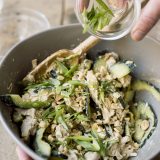Surely the rest of the world doesn’t dump a bucket of mayo onto overcooked chunks of chicken breast and call it salad? Celery, almonds and apples may attempt to lighten things up, but they’re usually no match for the smothering blandness of the mayonnaise. There must be a better way.
Our search for one took us to Asia, where cold chicken shines in dishes such as larb, the popular Thai recipe packed with tangy lemon grass and ginger. But our winner was found in China’s Sichuan province.
The name alone sold us: bang-bang chicken salad.
We loved the simplicity of the dish. Poached chicken is shredded, then tossed with a flavorful sauce, sesame paste and julienned vegetables such as cucumbers, then finished with something crunchy, often peanuts. This was a dish with layers of flavor and contrasting textures.
Conventional wisdom indicates the salad’s distinctive name comes from the way the dish is made—the chicken is pounded to shreds to allow the meat to better soak up a flavorful dressing. In reality, it is more likely derived from the Mandarin for “stick” (possibly a reference to the prep tool used to pound the chicken).
Either way, there’s science behind that banging, The fibers in chicken, especially breast meat, form long bundles surrounded by thin sheets of connective tissue—think of electrical wires wrapped in plastic. Those fibers must be exposed before they can absorb dressing. Shredding them, by way of pounding, is a highly effective way to accomplish this.
Because the chicken is poached in aromatics, flavor is built into this salad from the start. And the method couldn’t have been simpler. We used scallion whites, fresh ginger and garlic to flavor water and sherry. After submerging chicken breasts in the liquid, we brought it to a boil, then turned off the heat, allowing the chicken to finish cooking in residual heat. This flavored the meat and ensured it stayed tender and moist.
While the chicken cooked, we stirred together a vibrant dressing that combined rice vinegar and chili oil with cayenne pepper. Sichuan peppercorns—known for their tendency to deliver a tingling sensation on the tongue—gave us pleasant but not overwhelming heat. The peppercorns are optional, but don’t fear them. The chemicals that give them their zing, sanshools, are related to the capsaicin found in hot chili peppers; they merely act differently on the tongue.
As for the banging, we didn’t raise quite such a ruckus as the name implies. Mashing with a wooden spoon got us the right results (just use a sturdy bowl). To ensure the dressing and chicken really got together, we worked some of the dressing into the chicken shreds using our spoon-bowl method and served the rest of the dressing over the finished salad. Peanuts added crunch, and cucumber provided a cool contrast to our spiced-up chicken salad.




